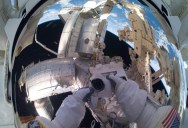Picture of the Day: Mysterious Roving Rocks of Racetrack Playa
MYSTERIOUS ROVING ROCKS OF RACETRACK PLAYA


In a particularly parched region of an extraordinary planet, rocks big and small glide across a mirror-flat landscape, leaving behind a tangle of trails. Some rocks travel in pairs, their two tracks so perfectly in synch along straight stretches and around curves that they seem to be made by a car. Others go freewheeling, wandering back and forth alone and sometimes traveling the length of several football fields. In many cases, the trails lead right to resting rocks, but in others, the joyriders have vanished.
This may sound like an alien world, but it’s actually Racetrack Playa in Death Valley, Calif. Since the 1940s, researchers have documented trails here and on several other playas in California and Nevada. Seventeen undergraduate and graduate students from the Lunar and Planetary Sciences Academy (LPSA) at NASA’s Goddard Space Flight Center in Greenbelt, Md., traveled to the Racetrack and nearby Bonnie Claire playas this summer to investigate how these rocks move across the nearly empty flats.
Some rocks are thought to have moved nearly as fast as a person walks. But nobody has actually seen a rock in motion, and scientists haven’t deduced exactly how it happens. The easy explanations—assistance from animals, gravity, or earthquakes—were quickly ruled out, leaving room for plenty of study and irresistible speculation over the years.
Some of the rocks that have moved weigh less than a pound, but many are 25–30 pounds. One of the largest sliders, named Karen, has been estimated at 700 pounds. A powerful force is required to move rocks that big, and the obvious candidate is the fierce playa wind. “It’s surprising when you see how big some of these boulders are,” says Ryan. “You think, ‘How can something that big get blown around?'”
Wind speeds of 150 miles per hour or more would probably be necessary to move most of the rocks. The wind speeds that graze the playa’s surface are very fast, but not that fast, so the newer studies tend to ask how the friction between the rocks and the clay might be reduced. [Source]
Trending on TwistedSifter




